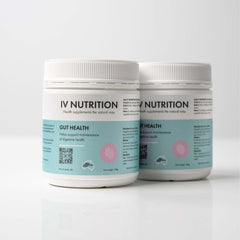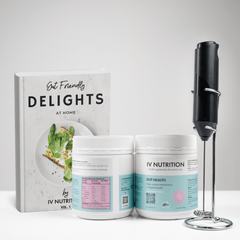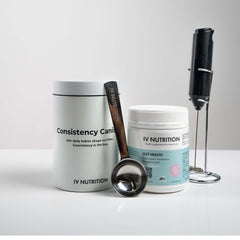Gut inflammation has become a silent epidemic, affecting millions of people who may not even realize the root of their fatigue, bloating, or brain fog is rooted in their digestive system. While occasional inflammation is a natural immune response, chronic gut inflammation can disrupt everything from your immune health to your mental clarity and metabolic function.
This clinical, science-based guide explores the causes, signs, and solutions to gut inflammation. Whether you're experiencing symptoms or looking to optimize your gut health proactively, we’ll break down the mechanisms behind digestive inflammation—and provide an actionable roadmap to support long-term healing.
We’ll also spotlight the power of prebiotic fibers, including a gentle, natural solution that supports healing at the root: IV Nutrition’s virgin-manufactured sugarcane prebiotic fiber, now available with 100% off your first tub when you subscribe.
Table of Contents
-
What Is Gut Inflammation?
-
Acute vs. Chronic Inflammation: Why It Matters
-
Symptoms of Digestive Inflammation
-
Root Causes: What Triggers Gut Inflammation?
-
The Role of the Gut Lining & Leaky Gut
-
How Inflammation Affects Your Microbiome
-
The Prebiotic Path to Healing: Fueling Your Gut from Within
-
Spotlight: Sugarcane-Derived Prebiotic Fiber from IV Nutrition
-
Best & Worst Foods for Gut Inflammation
-
Lifestyle Changes to Reverse Chronic Gut Inflammation
-
How Long Does It Take to Heal Gut Inflammation?
-
Final Thoughts: Restore, Rebuild, and Thrive
1. What Is Gut Inflammation?
At its core, gut inflammation refers to an overactive immune response in the gastrointestinal (GI) tract. This response is triggered when the gut perceives an irritant—like certain foods, pathogens, or toxins—as a threat.
While short-term (acute) inflammation can be beneficial in fighting off infections, chronic inflammation in the gut is damaging. Over time, it can erode the gut lining, alter the balance of beneficial bacteria, and set off a cascade of systemic health problems.
Inflammation in the gut can affect:
-
The intestinal lining (jejunum, ileum, colon)
-
The mucosal immune system
-
Microbial communities
-
Nutrient absorption pathways
And since nearly 70% of the immune system resides in the gut, digestive inflammation can influence your whole-body immune regulation.
2. Acute vs. Chronic Inflammation: Why It Matters
Not all inflammation is bad. In fact, your body relies on acute inflammation to deal with invaders or injury. It’s when inflammation becomes chronic and unresolved that problems begin.
| Type of Inflammation | Duration | Purpose | Risk |
|---|---|---|---|
| Acute | Hours to days | Defense and repair | Minimal |
| Chronic | Weeks to years | Ongoing immune overactivation | Tissue damage, dysfunction |
In the gut, chronic inflammation may develop subtly, but it sets the stage for disorders like fatigue, skin issues, autoimmune reactions, food sensitivities, and persistent GI distress.
3. Symptoms of Digestive Inflammation
Because gut inflammation impacts multiple body systems, the symptoms can be diverse:
-
Persistent bloating or gas
-
Constipation or loose stools
-
Abdominal discomfort or cramping
-
Fatigue, especially post-meal
-
Brain fog and trouble concentrating
-
Skin conditions (acne, eczema, psoriasis)
-
Sugar or carb cravings
-
Unexplained weight fluctuations
-
Food sensitivities that appear suddenly
If these symptoms are familiar, your gut may be inflamed—even if you've never had a diagnosed digestive disorder.
4. Root Causes: What Triggers Gut Inflammation?
Modern lifestyles create a near-perfect storm for chronic gut inflammation. The most common triggers include:
-
Ultra-processed foods: High in preservatives, emulsifiers, and seed oils
-
Excess sugar and artificial sweeteners
-
Low fiber intake: Starves beneficial bacteria
-
Overuse of antibiotics and NSAIDs
-
Chronic stress and poor sleep
-
Alcohol overconsumption
-
Environmental toxins: Including pesticides and heavy metals
-
Imbalanced gut microbiome (dysbiosis)
It’s usually not just one factor, but the accumulated effect of several over time that causes inflammation to take hold.
5. The Role of the Gut Lining & Leaky Gut
Your gut lining is a single layer of tightly bound cells that protect the body from harmful particles while allowing nutrients to be absorbed.
When inflamed, this lining can become permeable, allowing toxins, bacteria, and undigested food particles to enter the bloodstream—a condition often referred to as leaky gut.
This triggers widespread inflammation and can lead to:
-
Autoimmune responses
-
Hormonal imbalances
-
Joint pain
-
Mood disorders
-
Skin flare-ups
Healing the gut lining is essential to calming systemic inflammation.
6. How Inflammation Affects Your Microbiome
Chronic inflammation doesn't just damage the gut lining—it also disrupts your gut’s microbial balance. This condition, known as dysbiosis, occurs when harmful bacteria outnumber beneficial strains.
A dysbiotic gut microbiome:
-
Produces more inflammatory compounds
-
Has reduced diversity (linked to almost every chronic illness)
-
Impairs immune regulation
-
Promotes gas and bloating
-
Inhibits SCFA (short-chain fatty acid) production
To reverse this, you need to nourish beneficial bacteria—and that starts with prebiotic fiber.
7. The Prebiotic Path to Healing: Fueling Your Gut from Within
Prebiotics are non-digestible plant fibers that serve as food for beneficial gut bacteria. Unlike probiotics, which add bacteria, prebiotics strengthen your existing microbial ecosystem.
Why prebiotics are crucial for gut inflammation:
-
Increase butyrate production: Butyrate is a SCFA that reduces inflammation and heals the gut lining
-
Boost populations of beneficial bacteria like Bifidobacteria and Lactobacillus
-
Improve bowel regularity, preventing toxic buildup
-
Restore microbial diversity, linked to better immunity and mood
And not all fibers are created equal. High-quality prebiotics must be fermentable, gentle, and naturally derived—exactly what we explore next.
8. Spotlight: Sugarcane-Derived Prebiotic Fiber from IV Nutrition
One of the most powerful and gut-friendly forms of prebiotic fiber now available is virgin-manufactured sugarcane prebiotic fiber, available exclusively from IV Nutrition.
What Makes It Different?
-
Virgin-extracted: Unlike refined or heat-processed fibers, this is minimally processed for maximum integrity.
-
100% natural and non-GMO: Sourced from whole sugarcane—free from pesticides or fillers.
-
Soluble + insoluble fiber matrix: Supports microbial diversity while aiding elimination.
-
Gentle on the gut: Safe for sensitive stomachs or those recovering from inflammation.
It provides the raw materials your gut bacteria need to create anti-inflammatory SCFAs like butyrate, supporting both healing and long-term balance.
Special Offer: Try It Free
Right now, IV Nutrition is offering 100% off your first tub when you subscribe.
→ Click here to get your first tub free
Integrating this daily is one of the simplest, most effective strategies to begin reversing chronic gut inflammation—naturally.
9. Best & Worst Foods for Gut Inflammation
Top Anti-Inflammatory Foods for Gut Healing:
| Category | Examples |
|---|---|
| Prebiotic-rich | Garlic, onions, leeks, bananas |
| Omega-3 sources | Flaxseeds, chia seeds, wild salmon |
| Fermented foods | Sauerkraut, kefir, miso, yogurt |
| Polyphenol-rich | Berries, green tea, turmeric |
| Bone broth | Supports gut lining and joint health |
Foods That Fuel Inflammation:
| Avoid or Minimize | Reason |
|---|---|
| Refined sugar | Feeds harmful bacteria |
| Alcohol | Damages gut lining |
| Gluten (temporarily) | Can increase permeability |
| Industrial seed oils | High in omega-6, pro-inflammatory |
| Artificial additives | Disrupts microbiome and GI function |
10. Lifestyle Changes to Reverse Chronic Gut Inflammation
Healing the gut isn’t just about food—it’s about holistic balance.
1. Prioritize Sleep
Sleep is when your gut and immune system regenerate. Aim for 7–9 hours of uninterrupted rest nightly.
2. Reduce Stress
Stress activates the sympathetic nervous system, halting digestion and increasing gut inflammation. Practice daily breathwork, walks, or journaling.
3. Move Your Body
Moderate exercise enhances gut motility and increases microbial diversity.
4. Stay Hydrated
Water flushes out toxins and keeps your bowel movements regular.
5. Eliminate Triggering Medications When Possible
Work with your healthcare provider to reduce dependence on NSAIDs or antibiotics, which erode the gut lining and disrupt microbial balance.
11. How Long Does It Take to Heal Gut Inflammation?
Gut healing is not overnight—but with consistency, you can begin to feel better in weeks.
| Phase | Timeline | What’s Happening |
|---|---|---|
| Acute relief | 2–4 weeks | Bloating, cramping, and fatigue may ease |
| Rebuilding | 1–3 months | Lining repairs, microbiome rebalances |
| Sustaining | 3–6+ months | Long-term resilience and improved digestion |
Everyone heals at a different pace based on diet, stress levels, microbial diversity, and pre-existing damage. But the gut is always capable of healing with the right inputs.
12. Final Thoughts: Restore, Rebuild, and Thrive
Gut inflammation is at the root of many modern ailments, but it doesn't have to be permanent. The human body is remarkably adaptive and capable of repair—especially the gut, which replaces its lining every 3–7 days.
By eliminating inflammatory triggers, fueling your microbiome with targeted prebiotics, and adopting simple lifestyle changes, you create the conditions for deep healing and vibrant health.
Start with one step: nourish your gut with virgin sugarcane prebiotic fiber from IV Nutrition and give your body the building blocks it needs to thrive.





